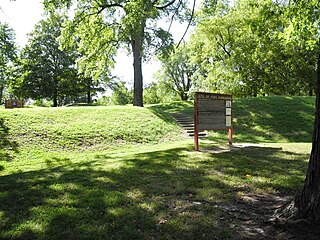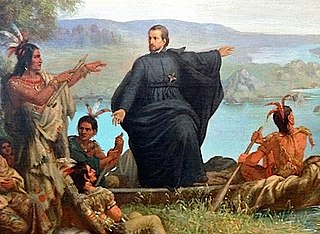
Kaskaskia is a village in Randolph County, Illinois. Having been inhabited by indigenous peoples, it was settled by France as part of the Illinois Country. It was named for the Kaskaskia people. Its population peaked at about 7,000 in the 18th century, when it was a regional center. During the American Revolutionary War, the town, which by then had become an administrative center for the British Province of Quebec, was taken by the Virginia militia during the Illinois campaign. It was designated as the county seat of Illinois County, Virginia, after which it became part of the Northwest Territory in 1787. Kaskaskia was later named as the capital of the United States' Illinois Territory, created on February 3, 1809. In 1818, when Illinois became the 21st U.S. state, the town briefly served as the state's first capital until 1819, when the capital was moved to more centrally located Vandalia.

The Illinois Confederation, also referred to as the Illiniwek or Illini, were made up of 12 to 13 tribes who lived in the Mississippi River Valley. Eventually member tribes occupied an area reaching from Lake Michicigao (Michigan) to Iowa, Illinois, Missouri, and Arkansas. The five main tribes were the Cahokia, Kaskaskia, Michigamea, Peoria, and Tamaroa. The spelling Illinois was derived from the transliteration by French explorers of iliniwe to the orthography of their own language. The tribes are estimated to have had tens of thousands of members, before the advancement of European contact in the 17th century that inhibited their growth and resulted in a marked decline in population.

The Illinois Country — sometimes referred to as Upper Louisiana —was a vast region of New France claimed in the 1600s in what is now the Midwestern United States. While those names generally referred to the entire Upper Mississippi River watershed, French colonial settlement was concentrated along the Mississippi and Illinois Rivers in what is now the U.S. states of Illinois and Missouri, with outposts on the Wabash River in Indiana. Explored in 1673 from Green Bay to the Arkansas River by the Canadien expedition of Louis Jolliet and Jacques Marquette, the area was claimed by France. It was settled primarily from the Pays d'en Haut in the context of the fur trade, and in the establishment of missions from Canada by French Catholic religious orders. Over time, the fur trade took some French to the far reaches of the Rocky Mountains, especially along the branches of the broad Missouri River valley. The French name, Pays des Ilinois, means "Land of the Illinois [plural]" and is a reference to the Illinois Confederation, a group of related Algonquian native peoples.

The Peoria are a Native American people. They are enrolled in the federally recognized Peoria Tribe of Indians of Oklahoma headquartered in Miami, Oklahoma.

Fort de Chartres was a French fortification first built in 1720 on the east bank of the Mississippi River in present-day Illinois. It was used as the administrative center for the province, which was part of New France. Due generally to river floods, the fort was rebuilt twice, the last time in limestone in the 1750s in the era of French colonial control over Louisiana and the Illinois Country.

The Wea were a Miami-Illinois-speaking Native American tribe originally located in western Indiana. Historically, they were described as either being closely related to the Miami Tribe or a sub-tribe of Miami.
The Tamaroa were a Native American people in the central Mississippi River valley of North America, and a member of the Illiniwek or Illinois Confederation of 12 or 13 tribes. The name "Tamaroa" is a derivative of the word tamarowa meaning "cut tail" in Illiniwek and relates to a totemic animal such as bear or wildcat. An Algonquian-speaking group, like the rest of the Illiniwek, they lived on both sides of the Mississippi River in the area of the confluence with the Illinois and Missouri Rivers. Tamaroan culture is presumed to be similar to that of the Kaskaskia, Peoria, and other Illinois tribes.

The American Bottom is the flood plain of the Mississippi River in the Metro-East region of Southern Illinois, extending from Alton, Illinois, south to the Kaskaskia River. It is also sometimes called "American Bottoms". The area is about 175 square miles (450 km2), mostly protected from flooding in the 21st century by a levee and drainage canal system. Immediately across the river from St. Louis, Missouri, are industrial and urban areas, but nearby marshland, swamps, and the Horseshoe Lake are reminders of the Bottoms' riparian nature.

Fort Kaskaskia State Historic Site is a 200-acre (0.8 km²) park near Chester, Illinois, on a blufftop overlooking the Mississippi River. It commemorates the vanished frontier town of Old Kaskaskia and the support it gave to George Rogers Clark in the American Revolution.

The Cahokia Courthouse State Historic Site is a reconstructed French-Canadian structure built about 1740 at what is now 107 Elm Street, Cahokia Heights, Illinois. At various times it has served as a house and as a courthouse. It is currently interpreted to resemble its appearance about 1800 as a frontier courthouse of the Northwest Territory. The courthouse was listed on the National Register of Historic Places on November 9, 1972.
The Mitchigamea or Michigamea or Michigamie were a tribe in the Illinois Confederation. Not much is known about them and their origin is uncertain. Originally they were said to be from Lake Michigan, perhaps the Chicago area. Mitchie Precinct, Monroe County in Southwestern Illinois takes its name from their transient presence nearby, north of the French Fort de Chartres in the American Bottom along the Mississippi. One of their villages in the American Bottom, inhabited from 1730 until 1752, is one of the region's premier archaeological sites; it is known as the "Kolmer Site".
Jacques Gravier was a French Jesuit missionary in the New World. He founded the Illinois mission in 1696, where he ministered to the several tribes of the territory. He was notable for his compilation of the most extensive dictionary of Kaskaskia Illinois-French among those made by French missionaries. In 1705 he was appointed Superior of the mission.

The Moingona or Moingwena were a historic Miami-Illinois tribe. They may have been close allies of or perhaps part of the Peoria. They were assimilated by that tribe and lost their separate identity about 1700. Today their descendants are enrolled in the Peoria Tribe of Indians of Oklahoma, a federally-recognized tribe.
Claude Charles du Tisné led the first official French expedition to visit the Osage and the Wichita Indians in 1719 in what became known as Kansas in the present-day United States.
The Cahokia were an Algonquian-speaking Native American tribe and member of the Illinois Confederation; their territory was in what is now the Midwestern United States in North America.

The Mission of the Guardian Angel was a 17th-century Jesuit mission in the vicinity of what is now Chicago, Illinois. It was established in 1696 by Father François Pinet, a French Jesuit priest. The mission was abandoned by 1700; its exact location remains unknown.

Le Grand Champ is an alluvial floodplain, also called a bottom, extending along the Mississippi River in Ste. Genevieve County, Missouri.

The Colonial history of Missouri covers the French and Spanish exploration and colonization: 1673–1803, and ends with the American takeover through the Louisiana Purchase














